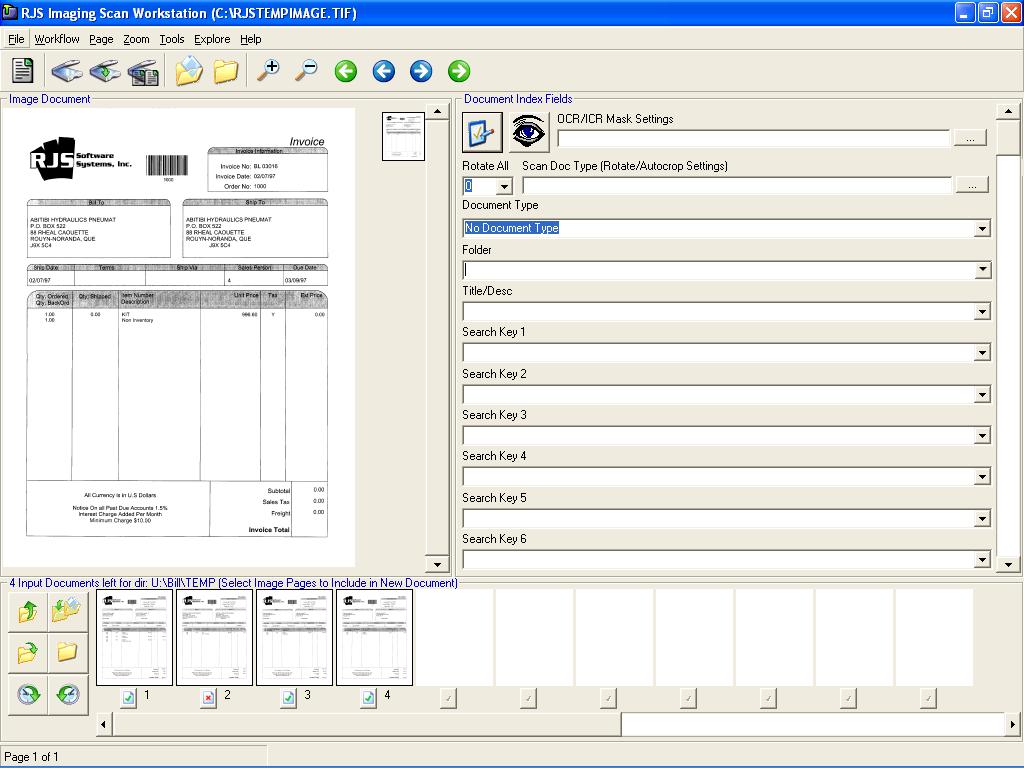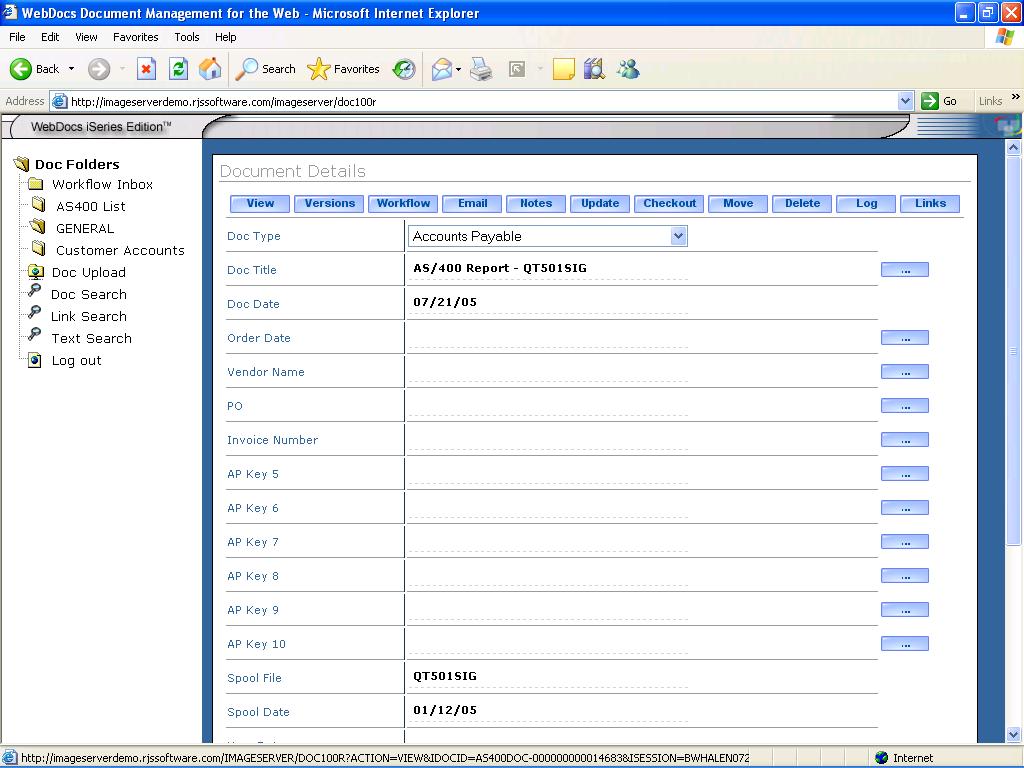Finding lost or missing paper documents is one of the biggest liabilities for businesses today. Employees waste thousands of hours each year digging through filing cabinets, storage rooms, and offsite vaults, searching for documents to resolve customer complaints, billing problems, contract disputes, and employee matters.
While it's important to save these documents to help resolve business and compliance issues, most companies have not taken steps to eliminate manual paper filing processes. By scanning paper documents into an electronic filing system, the physical versions of the documents should never need to be retrieved or accessed again if the documents are indexed correctly.
Indexing scanned documents by key fields such as order, invoice, customer, vendor or employee number, or any other meaningful value ensures that the manual paper retrieval process can be virtually eliminated.
Pain Points: Slow Service and Missing Documents
Imagine the following scenario: Company ABC calls to complain that it never received a shipment. The materials in question are worth over $100,000, so your company has a lot to lose if you can't verify the shipment was delivered. Your customer service rep promises to research and resolve the issue within 48 hours.
The customer service rep begins investigating the issue by searching for the proof-of-delivery document in the filing room. When the rep gets to Company ABC in the filing cabinet, the customer's folder is missing.
After sending frantic emails around the company and calling a remote warehouse, it's determined that a sales rep borrowed the folder to research the customer's purchasing habits and never returned it because his briefcase was stolen. All documentation for the order in question is gone. Without the signed delivery document, your business cannot collect the $100,000 payment, and Company ABC is left without a critical shipment of materials.
While this scenario may sound a little farfetched, this is the type of situation that happens quite often when companies use manual paper filing practices. Let's look at a solution to this problem.
Solution: Instant Access to Information
Suppose the company described above implements WebDocs, a native Web-based iSeries document management system from RJS Software Systems. All signed delivery documents are scanned and indexed by order and shipment number. Company ABC calls in with the same complaint. The customer service rep goes to the billing application screen on the iSeries, looks up the order, and presses a function key to find all documents related to the order.

Figure 1: Scan and index documents with WebDocs. (Click images to enlarge.)
The document list displays in a Web browser window so the user can easily locate and display the appropriate document. Seconds later, the customer service rep tells Company ABC that the $100,000 order was received by Joe at the plant's shipping dock. Company ABC talks to Joe, determines where the materials are, and quickly pays the invoice. Life is good.

Figure 2: Up to 10 search keys allow WebDocs users to search by doc type, dates, titles, and more.
Electronic Document Management ROI
By implementing an electronic document management system, the company described has achieved several important advantages:
- Paper documents are scanned and indexed as soon as they are received. This ensures that documents don't get lost or misplaced because an employee has borrowed or misfiled paper versions.
- Authorized employees can access order documents from their iSeries application within seconds.
- The company is protected against data loss due to fire or theft because documents are stored electronically and regularly backed up on tape.
- Employees are free to concentrate on more-important tasks, such as selling products, and the document management system improves customer service response times.
- The company streamlines customer service processes by making vendor and customer data available securely via a customer service Web site that connects order information and associated documents for easy access.
- Most importantly, the company can continue to grow with the same number of customer service employees since most requests can be handled via the Web.
Electronic document management software, such as WebDocs from RJS Software Systems, has become affordable and easy to implement. If you haven't taken steps to protect your critical business documents, RJS can help you determine if your company could benefit from document management software.
Visit the MC Press Resource Center to request the white paper that includes a free 30-day demo of WebDocs.
Richard Schoen is president of RJS Software Systems. He can be reached by telephone at 952.898.3038 or 888.RJSSOFT.




















 More than ever, there is a demand for IT to deliver innovation. Your IBM i has been an essential part of your business operations for years. However, your organization may struggle to maintain the current system and implement new projects. The thousands of customers we've worked with and surveyed state that expectations regarding the digital footprint and vision of the company are not aligned with the current IT environment.
More than ever, there is a demand for IT to deliver innovation. Your IBM i has been an essential part of your business operations for years. However, your organization may struggle to maintain the current system and implement new projects. The thousands of customers we've worked with and surveyed state that expectations regarding the digital footprint and vision of the company are not aligned with the current IT environment. TRY the one package that solves all your document design and printing challenges on all your platforms. Produce bar code labels, electronic forms, ad hoc reports, and RFID tags – without programming! MarkMagic is the only document design and print solution that combines report writing, WYSIWYG label and forms design, and conditional printing in one integrated product. Make sure your data survives when catastrophe hits. Request your trial now! Request Now.
TRY the one package that solves all your document design and printing challenges on all your platforms. Produce bar code labels, electronic forms, ad hoc reports, and RFID tags – without programming! MarkMagic is the only document design and print solution that combines report writing, WYSIWYG label and forms design, and conditional printing in one integrated product. Make sure your data survives when catastrophe hits. Request your trial now! Request Now. Forms of ransomware has been around for over 30 years, and with more and more organizations suffering attacks each year, it continues to endure. What has made ransomware such a durable threat and what is the best way to combat it? In order to prevent ransomware, organizations must first understand how it works.
Forms of ransomware has been around for over 30 years, and with more and more organizations suffering attacks each year, it continues to endure. What has made ransomware such a durable threat and what is the best way to combat it? In order to prevent ransomware, organizations must first understand how it works. Disaster protection is vital to every business. Yet, it often consists of patched together procedures that are prone to error. From automatic backups to data encryption to media management, Robot automates the routine (yet often complex) tasks of iSeries backup and recovery, saving you time and money and making the process safer and more reliable. Automate your backups with the Robot Backup and Recovery Solution. Key features include:
Disaster protection is vital to every business. Yet, it often consists of patched together procedures that are prone to error. From automatic backups to data encryption to media management, Robot automates the routine (yet often complex) tasks of iSeries backup and recovery, saving you time and money and making the process safer and more reliable. Automate your backups with the Robot Backup and Recovery Solution. Key features include: Business users want new applications now. Market and regulatory pressures require faster application updates and delivery into production. Your IBM i developers may be approaching retirement, and you see no sure way to fill their positions with experienced developers. In addition, you may be caught between maintaining your existing applications and the uncertainty of moving to something new.
Business users want new applications now. Market and regulatory pressures require faster application updates and delivery into production. Your IBM i developers may be approaching retirement, and you see no sure way to fill their positions with experienced developers. In addition, you may be caught between maintaining your existing applications and the uncertainty of moving to something new. IT managers hoping to find new IBM i talent are discovering that the pool of experienced RPG programmers and operators or administrators with intimate knowledge of the operating system and the applications that run on it is small. This begs the question: How will you manage the platform that supports such a big part of your business? This guide offers strategies and software suggestions to help you plan IT staffing and resources and smooth the transition after your AS/400 talent retires. Read on to learn:
IT managers hoping to find new IBM i talent are discovering that the pool of experienced RPG programmers and operators or administrators with intimate knowledge of the operating system and the applications that run on it is small. This begs the question: How will you manage the platform that supports such a big part of your business? This guide offers strategies and software suggestions to help you plan IT staffing and resources and smooth the transition after your AS/400 talent retires. Read on to learn:
LATEST COMMENTS
MC Press Online